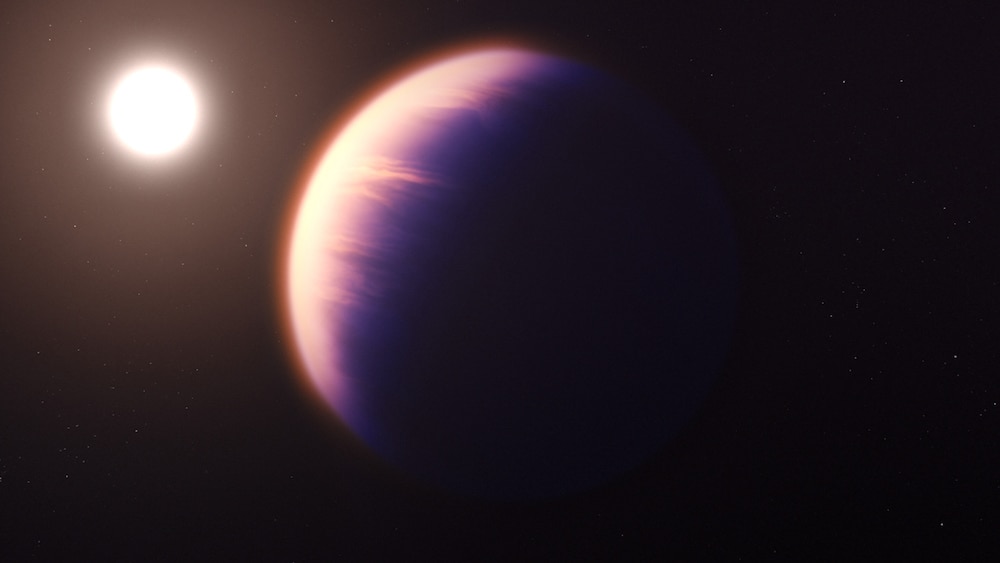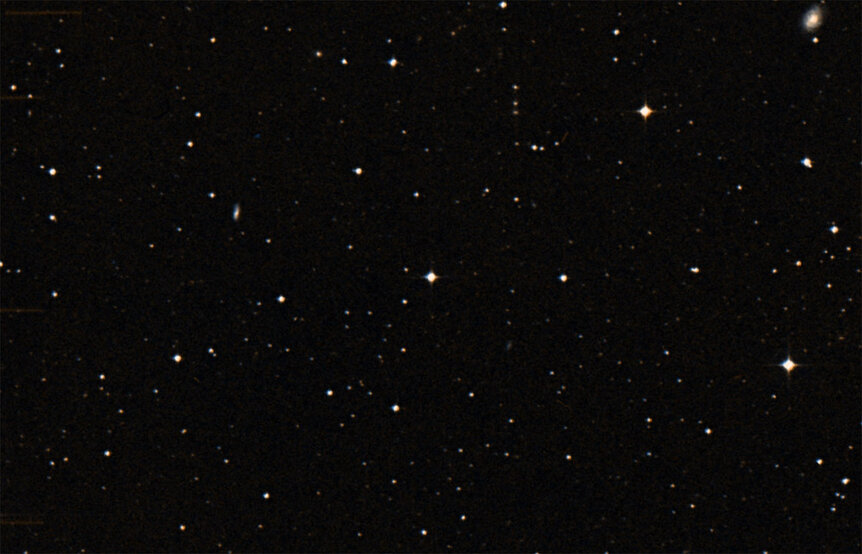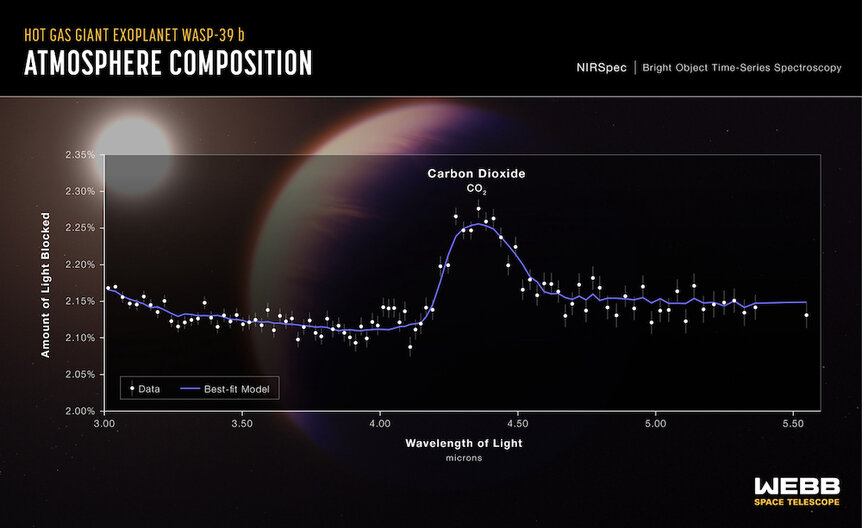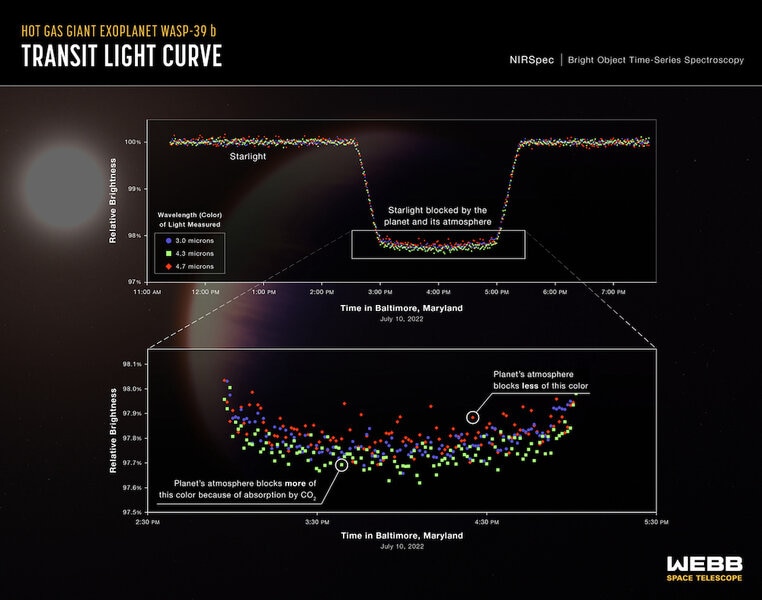Create a free profile to get unlimited access to exclusive videos, sweepstakes, and more!
JWST sees carbon dioxide in the atmosphere of an exoplanet for the first time
Discovery of CO2 hints at bigger ones to come.

Chalk up another first for JWST: Observations of an exoplanet have unambiguously detected the presence of carbon dioxide in its atmosphere, something that has never been done before. This will lead to a better understanding of how exoplanets form, and hints at the ability to detect atmospheric gases in smaller rocky worlds as well [link to paper].
The planet is called WASP-39b, which was discovered in 2011 with the Wide-angle Search for Planets program. This uses what are essentially digital cameras with telephoto lenses to look at large swaths of the sky that contain large numbers of stars, measuring their brightnesses over time. If we happen to see a planet’s orbit edge-on, then once per orbit it passes in front of the star, blocking a little bit of the star’s light. This is called a transit, and is the single most successful method we use to find these alien worlds.
The host star in this case, WASP-39, lies in the constellation of Virgo about 700 light-years from us. It’s very similar to the Sun, but has a somewhat lower mass, is a little smaller, and a little cooler. The planet orbits the star once almost exactly every 4 days, which means it’s very close in to the star, roughly 6.5 million kilometers above its surface — compare that to our innermost planet, Mercury, which is about 57 million kilometers from the Sun!
So this planet is scorching hot, about 900°C (1,650° F), so Earth-like it is not. It’s also a gas giant: Observations using the reflex velocity method show its mass to be about 90 times Earth’s — a little less than that of Saturn — so it’s a lot bigger and heftier than Earth. Even though it’s lower mass than Jupiter it’s actually bigger, certainly due to being puffy and inflated from all that heat.
Now here’s the very cool bit. When a planet with a thick atmosphere transits its star, some of that starlight will pass through the atmosphere on its way to us. Different atoms and molecules in the atmosphere absorb light at different wavelengths – think of them as colors — which can be used to identify them. By taking a spectrum, dividing the starlight into individual colors, we can look at what colors in the star’s light are dimmer, and those tell us what the atmospheric constituents are.
In reality it’s harder than this. For one thing, a lot of these molecules absorb light in the infrared, and that kind of light is absorbed by our atmosphere.
So we need space telescopes to detect it. And they have to be big to be able to catch enough light to make these observations.
And that’s one reason we have JWST. It looked at WASP-39b during a transit, using its NIRSpec instrument that takes infrared spectra. It saw a broad dip at about 4.3 microns, exactly where carbon dioxide in the atmosphere of the planet would absorb light! Turning this around, they graphed the amount of light blocked versus wavelength, so the presence of CO2 is seen as a bump in the plot:
This detection is incredibly strong; they report a probability of it being real as so high that it’s better than a 99.99999999(with lots more 9s)% of being true. I’m willing to go with that.
So why is this important? For one, the spectrum is very clean and the detection strong; Spitzer Space Telescope took a look at WASP-39b and saw a hint of CO2 but the detection was very ambiguous. This new one is not.
But it also tells us a lot about the planet. Astronomers have models of what planetary atmospheres should look like under different circumstances using the physics of gases, what we know about planets, and how they form in the first place. CO2 is an indicator of what astronomers weirdly call metals, meaning any elements heavier than helium*. Models of WASP-39b show that given the level of carbon dioxide found, its atmosphere is very likely to contain carbon monoxide, water vapor, and hydrogen sulfide (H2S, the molecule that makes rotten eggs stinky), but very little methane. The presence or lack of these molecules are harder to detect, though, but future observation may help.
Perhaps most exciting is the detection of CO2 in this planet hints that JWST will be able to see it in smaller planets, too. That’s much more difficult because a planet the size of Earth, say, blocks much less of the star so the amount of light that passes through its atmosphere is much less, meaning the signal of any given atmospheric constituent is lower. But JWST is a big ‘scope, and very sensitive, so the potential for it to be able to detect gas like carbon dioxide in a super-Earth or smaller world like our own is very interesting indeed.
And there are still mysteries to solve with the data in hand, too. There’s an odd bump in the spectrum of WASP39-b at about 4 microns. It’s not strong enough to claim as real, but it showed up in the data no matter how the astronomers processed them. The thing is, the models don’t predict it to be there. So if it’s real it’s something unexpected. It could be a byproduct of the chemistry going on in the air there, or some other molecule that happens to be floating around. Or it may simply be a statistical fluctuation, like getting heads three times in a row while tossing a coin.
More observations would help, but time on JWST is subscribed to the hilt, so it may be a while before we see any follow-up. In the meantime other planets await, their atmospheres loaded with chemistry that now, finally, we get a chance to see clearly.
*To be fair, the Universe is almost entirely hydrogen and helium, with everything else being more of an impurity. Planets are an exception, where heavier elements can exist, accumulated locally in the nebula from which they formed.





























